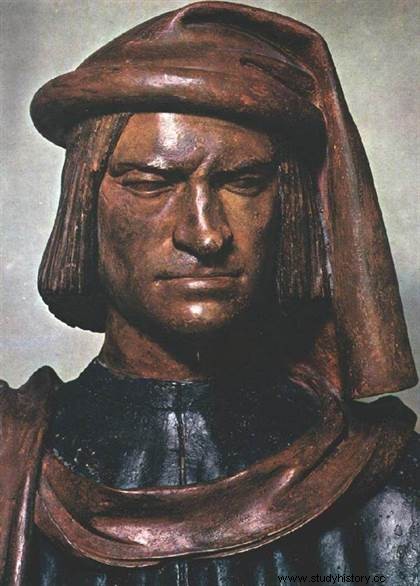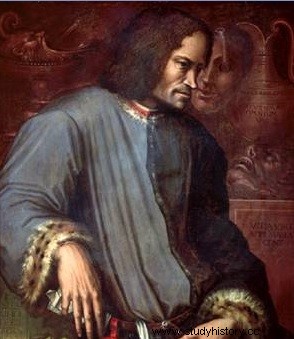 Italian Renaissance Prince, Laurenius de Medici (nicknamed Laurent the Magnificent ) ruled the Republic of Florence from 1469 to 1492. Coming from a family of wealthy bankers, the Medici, Lorenzo succeeded his father in 1469 at the head of this "city-state" and succeeded in making Florence the most powerful of the Italian states. Poet of great talent, patron and protector of arts and letters, he attracted to his court the greatest artists of the time, such as Sandro Botticelli or Michelangelo. Along with others, such as the Duke of Urbino Federico da Montefeltro, he well represents the type of Italian prince interested in the arts, and who enabled – along with the artists themselves – the artistic explosion that led to the Renaissance.
Italian Renaissance Prince, Laurenius de Medici (nicknamed Laurent the Magnificent ) ruled the Republic of Florence from 1469 to 1492. Coming from a family of wealthy bankers, the Medici, Lorenzo succeeded his father in 1469 at the head of this "city-state" and succeeded in making Florence the most powerful of the Italian states. Poet of great talent, patron and protector of arts and letters, he attracted to his court the greatest artists of the time, such as Sandro Botticelli or Michelangelo. Along with others, such as the Duke of Urbino Federico da Montefeltro, he well represents the type of Italian prince interested in the arts, and who enabled – along with the artists themselves – the artistic explosion that led to the Renaissance.
Laurent de Medici, Prince of Florence
Laurent de Medici (not to be confused with the one to whom Machiavelli will offer his Prince) was born in Florence on January 1, 1449. He is the son of Pierre de Médicis, known as "the Goutteux”, whom he succeeded in 1469. But he was also the grandson of Côme the Elder, who had already distinguished himself in his relationship with the arts. It was also Como who installed the Medici lordship, which in fact governs Florence, even though it is supposed to be a Republic.
 The young Laurent received a humanist education and was interested in the arts and philosophy quite early. He would have been introduced to architecture by Leon Batista Alberti himself. Very early on, he was in contact with circles of Florentine power, but also with the sons of other princes, such as the Sforzas of Milan, and his father did not hesitate to send him on a diplomatic mission, including to Rome.
The young Laurent received a humanist education and was interested in the arts and philosophy quite early. He would have been introduced to architecture by Leon Batista Alberti himself. Very early on, he was in contact with circles of Florentine power, but also with the sons of other princes, such as the Sforzas of Milan, and his father did not hesitate to send him on a diplomatic mission, including to Rome.
Laurent succeeded Peter le Goutteux in December 1469. At that time, the Medici had many enemies in Florence, and they hoped to take advantage of the transition of power to overthrow the Medici family. However, they do not expect the violence of Laurent who, very quickly, imposes himself against them, not hesitating to have any opponents beheaded. Similarly, he hired the condottiere Federico da Montefeltro to put down the rebellions in the Florence region. The Florentine prince even goes so far as to openly oppose Pope Sixtus IV.
The fight against the Pope
Nevertheless, it was the conspiracy of the Pazzi (1478) that allowed him to establish his power. Led by a rival family of the Medici, it almost causes the downfall of the latter, and Laurent loses his brother Julien. The Medici finds himself facing Pope Sixtus IV (who encouraged the Pazzi), Siena and the King of Naples, but he obtains the support of Ludovico the Moor. On the other hand, the King of France Louis XI prefers to stay away.
Laurent the Magnificent narrowly escapes death during a religious service, helped by the humanist poet Ange Politien; the Florentine republic and its population then turned against the conspirators. His allies defeated, the pope decides to excommunicate the Florentine prince and to impose a ban on his city, then he manages to defeat the armies of Florence, following the defection of the Milanese, at the battle of Poggio Imperiale. Lorenzo de Medici did not admit defeat and this time used diplomacy to get out of this delicate situation:he made peace with Naples, which pushed Sixtus IV to negotiate, and finally to lift the ban in 1480. peace thus allows the prince to consolidate his power in the Florentine city.
 The remainder of Lorenzo the Magnificent's reign is somewhat quieter internationally (despite the Ferrara War) , and even in Florence, and the prince appears as someone wise, far from the violent image of his beginnings. However, his family had to face other dangers, the economic difficulties that hit the Medici bank. This does not prevent the prince from turning to the arts and presenting himself as an important patron, with little regard for expenditure.
The remainder of Lorenzo the Magnificent's reign is somewhat quieter internationally (despite the Ferrara War) , and even in Florence, and the prince appears as someone wise, far from the violent image of his beginnings. However, his family had to face other dangers, the economic difficulties that hit the Medici bank. This does not prevent the prince from turning to the arts and presenting himself as an important patron, with little regard for expenditure.
Laurent the Magnificent and the arts
The Florentine statesman was introduced to the arts and literature from childhood. It is therefore logical that once in power, he becomes a patron prince and supports the greatest artists of his time. With him, Florence asserts itself as the capital of the arts. He thus became the friend and protector of the humanist philosopher Marsile Ficin, but also of Ange Politien, supporting the neo-Platonic movement. Like his predecessors, he commissioned works of art, for example from Verrocchio (master of Leonardo da Vinci and Perugino) or even Filippino Lippi, Domenico Ghirlandaio, Botticelli (close to his brother Julien, of whom he painted a famous portrait) and young Michelangelo. Lorenzo the Magnificent was himself a poet in his spare time, and he wrote several works especially during the 1470s, influenced by the neo-Platonism of Ficino, even by Dante.
 This period also saw the face of Florence change, under the impulse of the prince. With the architect Giuliano da Sangallo, heir to the tradition of Brunelleschi, the church of Santa Maria delle Carceri in Prato, the sacristy of the church of Santo Spiritu, and the Villa of Poggio a Caiano were built. As for Benedetto da Maiano, he built the Strozzi Palace. The Florence of Lorenzo the Magnificent ushers us right into the Renaissance.
This period also saw the face of Florence change, under the impulse of the prince. With the architect Giuliano da Sangallo, heir to the tradition of Brunelleschi, the church of Santa Maria delle Carceri in Prato, the sacristy of the church of Santo Spiritu, and the Villa of Poggio a Caiano were built. As for Benedetto da Maiano, he built the Strozzi Palace. The Florence of Lorenzo the Magnificent ushers us right into the Renaissance.
At the end of his life, Lorenzo de Medici favored the arrival in Florence of the monk Savonarola, which would have important consequences for the continuation of the political life of the Florentine city. . Indeed, ill in 1491, Laurent died in April 1492. His son Pierre succeeded him, but he was banished two years later; it was then Savonarola himself who took power, to the great displeasure of a certain Machiavelli…
Bibliography
- I. Cloulas, Laurent the Magnificent, Fayard, 1982.
- Laurent the Magnificent, biography of Pierre Racine. Ellipses, 2015.
